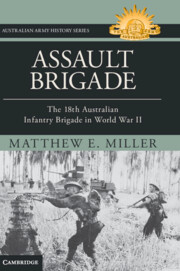Refine search
Actions for selected content:
15401 results in Military history
Bibliography
-
- Book:
- Soldiers of Uncertain Rank
- Published online:
- 17 October 2024
- Print publication:
- 31 October 2024, pp 223-241
-
- Chapter
- Export citation
4 - The Reorientation of the West India Regiments
-
- Book:
- Soldiers of Uncertain Rank
- Published online:
- 17 October 2024
- Print publication:
- 31 October 2024, pp 84-113
-
- Chapter
- Export citation
Acknowledgements
-
- Book:
- Soldiers of Uncertain Rank
- Published online:
- 17 October 2024
- Print publication:
- 31 October 2024, pp xi-xii
-
- Chapter
- Export citation
Abbreviations
-
- Book:
- Soldiers of Uncertain Rank
- Published online:
- 17 October 2024
- Print publication:
- 31 October 2024, pp xiii-xiv
-
- Chapter
- Export citation
8 - Remembering the West India Regiments
-
- Book:
- Soldiers of Uncertain Rank
- Published online:
- 17 October 2024
- Print publication:
- 31 October 2024, pp 207-222
-
- Chapter
- Export citation
6 - Neither Soldiers nor Warriors
-
- Book:
- Soldiers of Uncertain Rank
- Published online:
- 17 October 2024
- Print publication:
- 31 October 2024, pp 144-173
-
- Chapter
- Export citation
3 - Establishing the Steady Black Soldier
-
- Book:
- Soldiers of Uncertain Rank
- Published online:
- 17 October 2024
- Print publication:
- 31 October 2024, pp 53-83
-
- Chapter
- Export citation
7 - Bringing the Troops Home
-
- Book:
- Soldiers of Uncertain Rank
- Published online:
- 17 October 2024
- Print publication:
- 31 October 2024, pp 174-206
-
- Chapter
- Export citation
5 - Displaying Valour
-
- Book:
- Soldiers of Uncertain Rank
- Published online:
- 17 October 2024
- Print publication:
- 31 October 2024, pp 114-143
-
- Chapter
- Export citation
Copyright page
-
- Book:
- Soldiers of Uncertain Rank
- Published online:
- 17 October 2024
- Print publication:
- 31 October 2024, pp iv-iv
-
- Chapter
- Export citation

Assault Brigade
- The 18th Australian Infantry Brigade in World War II
-
- Published online:
- 25 October 2024
- Print publication:
- 12 August 2024

Soldiers of Uncertain Rank
- The West India Regiments in British Imperial Culture
-
- Published online:
- 17 October 2024
- Print publication:
- 31 October 2024
Appendix 8.3 - Salinator’s Triumph – or Nero’s Also?
- from Chapter 8 - The Tipping Point
-
- Book:
- Hannibal and Scipio
- Published online:
- 05 September 2024
- Print publication:
- 26 September 2024, pp 201-201
-
- Chapter
- Export citation
Chapter 8 - The Tipping Point
-
- Book:
- Hannibal and Scipio
- Published online:
- 05 September 2024
- Print publication:
- 26 September 2024, pp 182-206
-
- Chapter
- Export citation
Additional material
-
- Book:
- Hannibal and Scipio
- Published online:
- 05 September 2024
- Print publication:
- 26 September 2024, pp xix-xix
-
- Chapter
- Export citation
Chapter 16 - Hannibal and Scipio
-
- Book:
- Hannibal and Scipio
- Published online:
- 05 September 2024
- Print publication:
- 26 September 2024, pp 337-368
-
- Chapter
- Export citation
Prologue
-
- Book:
- Hannibal and Scipio
- Published online:
- 05 September 2024
- Print publication:
- 26 September 2024, pp 1-8
-
- Chapter
- Export citation
Chapter 18 - The Downfall and Death of Scipio, 187–183
-
- Book:
- Hannibal and Scipio
- Published online:
- 05 September 2024
- Print publication:
- 26 September 2024, pp 384-394
-
- Chapter
- Export citation
Appendix 1.2 - Plutarch’s Lost Lives of Scipio
- from Chapter 1 - Hannibal and Scipio on Themselves
-
- Book:
- Hannibal and Scipio
- Published online:
- 05 September 2024
- Print publication:
- 26 September 2024, pp 31-33
-
- Chapter
- Export citation
Reviews
-
- Book:
- Hannibal and Scipio
- Published online:
- 05 September 2024
- Print publication:
- 26 September 2024, pp ii-ii
-
- Chapter
- Export citation
